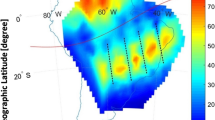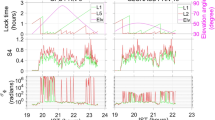Abstract
The impact of equatorial plasma bubbles (EPBs) on signals from navigation satellites has remained unpredictable. EPBs could be tracked to some extent with prior knowledge of zonal drift and other important parameters associated with scintillations for a given local time. Aiming for this, we analyze high-rate carrier-to-noise (C/N0) GPS L1 signals recorded using a software GNSS receiver during February–April 2015. In the absence of an automated algorithm in this domain, a new algorithm is developed for estimation of power spectra, Fresnel frequency, noise floor, spectral slope, and ionospheric zonal irregularity drift using per minute scintillation patches. Importantly, since multipath and scintillation can co-occur at lower elevation angles, a new criterion for multipath identification and separation from scintillation and fading is defined as part of the automated algorithm. The C/N0 data above the threshold value of 0.17 of the scintillation index (S4) are only considered by this algorithm. Details of the approach and method are presented with example sets. Results for the estimated zonal drifts, spectral index, and decorrelation length of the post-sunset irregularities are illustrated. Variations in these parameters are presented along with local time, latitude, and longitude of the ionospheric pierce points. The drastic variations that a GPS user and a forecaster would encounter in equatorial latitudes are explained in terms of the challenge they pose. This study is probably the first in terms of automation of the process that shall be highly useful for single-station scintillation observations.












Similar content being viewed by others
References
Aaron J, Basu S (1994) Ionospheric amplitude and phase fluctuations at the GPS frequencies. In: Proceedings of the ION GPS-94, Salt Lake City, UT, The Institute of Navigation, pp 1569–1578
Abadi P, Saito S, Srigutomo W (2014) Low-latitude scintillation occurrences around the equatorial anomaly crest over Indonesia. Ann Geophys 32:7–17. https://doi.org/10.5194/angeo-32-7-2014
Andima G, Amabayo EB, Jurua E, Cilliers PJ (2018) Characterization of the low latitude plasma density irregularities observed using C/NOFS and SCINDA data. Adv Space Res 61(1):264–273. https://doi.org/10.1016/j.asr.2017.08.003
Axealrad P, Comp CJ, Macdoran PF (1996) SNR-based multipath error correction for GPS differential phase. IEEE Trans Aerospace Electronic Syst 32:650–660
Banola S, Pathan BM, Rao DRK, Chandra H (2005) Spectral characteristics of scintillations producing ionospheric irregularities in the Indian region. Earth Planets Space 57:47–59
Basu S, Basu S (1981) Equatorial scintillations—a review. J Atmos Terr Phys 43(5–6):473–489. https://doi.org/10.1016/0021-9169(81)90110-0
Basu S, Basu S, Kudeki E, Zengingonul HP, Biondi MA, Meriwether JW (1991) Zonal irregularity drifts and neutral winds measured near the magnetic equator in Peru. J Atmos Terr Phys 53:743
Bhattacharyya A, Rastogi RG (1985) Amplitude scintillation during early and late phases of evolution of irregularities in the nighttime equatorial ionosphere. Radio Sci 20(4):935–946
Bhattacharyya A, Yeh KC, Franke SJ (1992) Deducing turbulence parameters from transionospheric scintillation measurements. Space Sci Rev 16:286–335. https://doi.org/10.1007/BF00222311
Bhattacharyya A, Kakad B, Gurram P, Sripathi S, Sunda S (2017) Development of intermediate-scale structure at different altitudes within an equatorial plasma bubble: implications for L-BAND scintillations. J Geophys Res 122:1015–1030
Bilich A, Larson KM (2007) Mapping the GPS multipath environment using the signal-to-noise ratio (SNR). Radio Sci 42:RS6003. https://doi.org/10.1029/2007RS003652
Braasch MS, Van Dierendonck AJ (1999) GPS receiver architectures and measurements. Proc IEEE 87(1):48–64
Carrano CS, Groves KM (2010) Temporal decorrelation of GPS satellite signals due to multiple scattering from ionospheric irregularities. In: Proceedings of the ION GNSS-10, Portland, OR, The Institute of Navigation, pp 361–374
Carrano CS, Rino C (2016) A theory of scintillation for two-component power law irregularity spectra: overview and numerical results. Radio Sci 51(6):789–813
Carrano CS, Groves KM, Rino CL, Doherty PH (2016) A technique for inferring zonal irregularity drift from single-station GNSS measurements of intensity (S4) and phase (σφ) scintillations. Radio Sci 51:1263–1277. https://doi.org/10.1002/2015RS005864
Chandra H, Vyas GD, Sinha HSS, Misra RN, Prakash S (1992) Ionospheric scintillation observations from SHAR. J Atmos Terr Phys 54:167–172
Cleveland WS (1979) Robust locally weighted regression and smoothing scatterplots. J Am Stat Assoc 74:829–836
Coley WR, Stoneback RA, Heelis RA, Hairston MR (2014) Topside equatorial zonal ion velocities measured by C/NOFS during rising solar activity. Ann Geophys 32:69–75. https://doi.org/10.5194/angeo-32-69-2014
Dashora N, Pandey R (2005) Observations in equatorial anomaly region of total electron content enhancements and depletions. Ann Geophys 23(7):2449–2456. https://doi.org/10.5194/angeo-23-2449-2005
Dashora N, Taori A, Patra AK (2012) Multi-instrument observations of winter solstice F-region irregularities during the low solar activity. Ind J Radio Space Phys 41(2):220–232
Dyson PL, McClufe JP, Hanson WB (1974) In situ measurements of the spectral characteristic of F regionionospheric irregularities. J Geophys Res 79:1497–1502
Engavale B, Bhattacharyya A (2005) Spatial correlation function of intensity variations in the ground scintillation pattern produced by equatorial spread-F irregularities. Indian J Radio Space Phys 34(1):22–32
Forte B (2012) Analysis of strong ionospheric scintillation events measured by means of GPS signals at low latitudes during disturbed conditions. Radio Sci 47:RS4009. https://doi.org/10.1029/2011RS004789
Forte B, Radicella SM (2002) Problems in data treatment for ionospheric scintillation measurements. Radio Sci 37(6):1096. https://doi.org/10.1029/2001RS002508
Horemuz M, Andersson JV (2006) Polynomial interpolation of GPS satellite coordinates. GPS Solut 10(1):67–72
Humphreys TE, Psiaki ML, Kintner PM Jr (2010) Modeling the effects of ionospheric scintillation on GPS carrier phase tracking. IEEE Trans Aerosp Electron Syst 46:1624–1637. https://doi.org/10.1109/TAES.2010.5595583
Ji S, Chen W, Weng D, Wang Z (2015) Characteristics of equatorial plasma bubble zonal drift velocity and tilt based on Hong Kong GPS CORS network: from 2001 to 2012. J Geophys Res Space Phys. https://doi.org/10.1002/2015JA021493-T
Kintner PM, Kil H, Beach TL, de Paula ER (2001) Fading timescales associated with GPS signals and potential consequences. Radio Sci 36:731–743. https://doi.org/10.1029/1999RS002310
Kintner PM, Ledvina BM, de Paula ER, Kantor IJ (2004) Size, shape, orientation, speed, and duration of GPS equatorial anomaly scintillations. Radio Sci 39:RS2012. https://doi.org/10.1029/2003RS002878
Li G, Ning B, Yuan H (2007) Analysis of ionospheric scintillation spectra and TEC in the Chinese low latitude region. Earth Planets Space 59(4):279–285
Magdaleno S, Herraiz M, Altadill D, de la Morena BA (2017) Climatology characterization of equatorial plasma bubbles using GPS data. J Space Weather Space Clim 7:A3. https://doi.org/10.1051/swsc/2016039
Moraes AO et al (2018) GPS availability and positioning issues when the signal paths are aligned with ionospheric plasma bubbles. GPS Solut 22:95. https://doi.org/10.1007/s10291-018-0760-8
Muella MTAH, Duarte-Silva MH, Moraes AO, de Paula ER, Rezende LFC, Alfonsi L, Affonso BJ (2017) Climatology and modeling of ionospheric scintillations and irregularity zonal drifts at the equatorial anomaly crest region. Ann Geophys 35:1201–1218. https://doi.org/10.5194/angeo-35-1201-2017
de Oliveira Nascimento Brassarote G, de Souza EM, Monico JFG (2018) S 4 index: does it only measure ionospheric scintillation? GPS Solut 22(1):8. https://doi.org/10.1007/s10291-017-0666-x
Paul A, Ray S, DasGupta A, Garg SC (2002) First in situ observations of equatorial ionospheric bubbles by Indian satellite SROSS-C2 and simultaneous multisatellite scintillations. Radio Sci 37(5):1087. https://doi.org/10.1029/2001RS002519
Prakash S, Pal S, Chandra H (1991) In-situ studies of equatorial spread-F over SHAR—steep gradients in the bottomside F-region and transitional wavelength results. J Atmos Terr Phys 53(10):977–986
Rama Rao PVS, Krishna SG, Niranjan K, Prasad DSVVD (2006) Study of spatial and temporal characteristics of L-band scintillations over the Indian low-latitude region and their possible effects on GPS navigation. Ann Geophys 24(6):1567–1580
Rino CL (1979) A power law phase screen model for ionospheric scintillation: 1. Weak scatter. Radio Sci 14(6):1135–1145. https://doi.org/10.1029/RS014i006p01135
Rino CL (2011) The theory of scintillation with applications in remote sensing. Wiley, Hoboken
Seo J, Walter T, Chiou T, Enge P (2009) Characteristics of deep GPS signal fading due to ionospheric scintillation for aviation receiver design. Radio Sci 44:RS0A16. https://doi.org/10.1029/2008RS004077
Singleton DG (1974) Power spectra of ionospheric scintillations. J Atmos Terr Phys 36:113–133. https://doi.org/10.1016/0021-9169(74)90071-3
Spogli L et al. (2014) A filtering method developed to improve GNSS receiver data quality in the CALIBRA project. INTECH open science open mind
Srinivasu VKD, Dashora N, Prasad DSVVD, Niranjan K, Gopi Krishna S (2018) On the occurrence and strength of multi-frequency multi-GNSS ionospheric scintillation in Indian sector during declining phase of solar cycle 24. Adv Space Res 61(7):1761–1775. https://doi.org/10.1016/j.asr.2017.08.036
Strangeways HJ, Tiwari R (2013) Prediction and mitigation of ionospheric scintillation and tracking jitter for GNSS positioning. Proceedings ELMAR-2013, Zadar, pp 319–322
Strangeways HJ, Ho YH, Aquino MHO, Elmas ZG, Marques HA, Monico JFG, Silva HA (2011) On determining spectral parameters, tracking jitter, and GPS positioning improvement by scintillation mitigation. Radio Sci 46:15. https://doi.org/10.1029/2010RS004575
Strangeways HJ, Gherm VE, Zernov NN (2014) Comparison of 4 methods for transionospheric scintillation evaluation. Radio Sci. https://doi.org/10.1002/2014RS005408
Strode R, Groves P (2015) GNSS multipath detection using three-frequency signal-to-noise measurements. GPS Solut 20(3):399–412. https://doi.org/10.1007/s10291-015-0449-1
Yeh KC, Liu CH (1982) Radio wave scintillations in the ionosphere. Proc IEEE 70:324–360. https://doi.org/10.1109/PROC.1982.12313
Yokoyama T (2017) A review on the numerical simulation of equatorial plasma bubbles toward scintillation evaluation and forecasting. Prog Earth Planet Sci 4:37. https://doi.org/10.1186/s40645-017-0153-6
Acknowledgments
Authors gratefully acknowledge the International GNSS Service (IGS) for providing GNSS final combined orbit solution product at NASA crustal dynamics data information system (CDDIS) accessed at ‘ftp://cddis.nasa.gov/gnss/products/’ and coordinated data analysis web (CDAWeb) at Goddard space flight data center (GSFC) accessed at ‘https://cdaweb.gsfc.nasa.gov/index.html/’ for providing IDM data onboard C/NOFS satellite. We thank Alahari Neelima for her contribution to API development for scintillation recording using SX-NSR. Software receiver ‘SX-NSR’ has been procured at NARL under the GNSS receiver network project supported by the Department of Space, Govt. of India.
Author information
Authors and Affiliations
Corresponding author
Additional information
Publisher's Note
Springer Nature remains neutral with regard to jurisdictional claims in published maps and institutional affiliations.
Rights and permissions
About this article
Cite this article
Sethi, H.S., Dashora, N. Automated power spectrum analysis of low-latitude ionospheric scintillations recorded using software GNSS receiver. GPS Solut 24, 33 (2020). https://doi.org/10.1007/s10291-019-0945-9
Received:
Accepted:
Published:
DOI: https://doi.org/10.1007/s10291-019-0945-9




